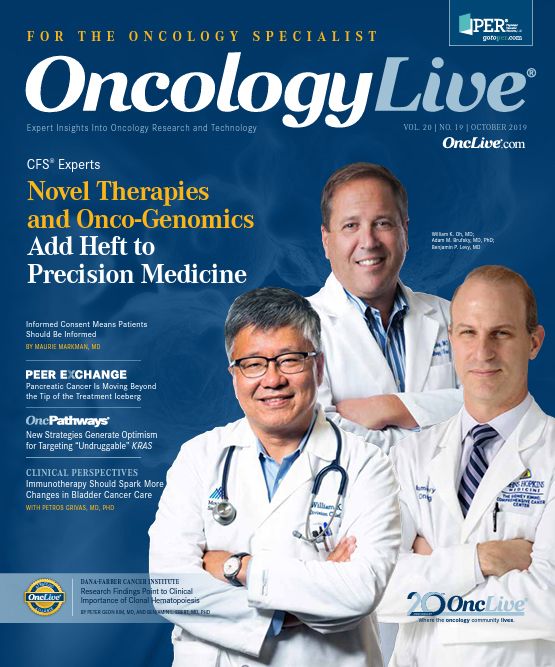Publication
Article
Informed Consent Means Patients Should Be Informed
Author(s):
There is no more important principle in the conduct of legitimate therapeutic investigation than ensuring the adequacy of informed consent of the prospective clinical trial participant.
Maurie Markman, MD, editor in chief, is president of Medicine and Science at Cancer Treatment Centers of America and clinical professor of medicine, Drexel University College of Medicine

Maurie Markman, MD
There is no more important principle in the conduct of legitimate therapeutic investigation than ensuring the adequacy of informed consent of the prospective clinical trial participant. Prior to obtaining an individual’s signature on an institutional review board—approved document, investigators must provide the prospective enrollee with a thorough description of the goals of the study at a language level appropriate to optimize understanding by someone without clinical credentials. This description must include the potential risks or benefits to the extent known prior to or learned during the conduct of the study and also what is expected of the research subject—for example, time spent in the clinic and the number of return visits.
The consent process must also include a full description of alternative strategies that might be employed in a similar clinical setting. Again, investigators must include an objectively valid description of the known risks and benefits of these alternative approaches. This is the case whether the alternatives have not been approved for the specific setting being evaluated in the clinical trial (ie, a pharmaceutical drug investigation designed to ultimately result in regulatory approval) or are FDA approved for use outside the realm of investigation.
Consider, for example, the somewhat disturbing history of drug development in the management of ovarian cancer where, for a period of time, women who agreed to participate in platinum-resistant disease trials were randomized to receive pegylated liposomal doxorubicin at an initial dose of 50 mg/m2 in a “study control arm” because this was the FDA-approved dose, even though a lower, far less toxic dose (generally 40 mg/m2) was routinely employed by oncologists and considered to be equivalent in terms of efficacy to the higher, more toxic dose.1,2 The concern here is that use of an unnecessarily high toxic dose for a control arm has the potential to inflate the apparent value of an experimental regimen.
Informed consent guidelines require that data be clearly explained if they might lead some, including the patient being asked to become a research subject, to question the wisdom of trial participation. There is a longstanding debate over when a physician should recommend that a patient consider entry into a randomized trial. Medical ethicists have suggested that clinicians should encourage participation only if they believe that between the control and investigational arms there is legitimate equipoise of potential benefits and harms associated with the study regimens.3
For example, if a treating oncologist believes that a randomized study holds the promise of superior efficacy based on existing data on the study arms, it would be appropriate for that physician to offer the patient trial participation. Conversely, if the individual physician believes the available data suggested 1 study arm is superior (efficacy, toxicity, or both), the decision to offer the patient trial participation could be ethically problematic. Although the individual-physician perspective is somewhat controversial, it is highlighted here to emphasize the extreme importance of providing patients with all relevant available clinical data that might influence a decision to enter a randomized trial.
Now, consider several contemporary oncology settings where the adequacy of informed consent merits a close examination.
A recent, 7-year follow-up of a single-arm phase II trial (N = 410) of adjuvant paclitaxel plus trastuzumab in node-negative but HER2-positive breast cancer (<3 cm in size) revealed disease-free and overall survival (OS) rates of 93% and 95%, respectively.4 The trial enrolled patients from October 2007 through September 2010. Although the results are impressive, some might conclude they are less than definitive because the data were not obtained through the conduct of a phase III randomized trial.
Should a clinical investigator doing a similar study in the future fully inform prospective trial participants of the details of the phase II paclitaxel/trastuzumab trial—including the 7-year follow-up survival data? Should physicians provide this information if they are considering asking patients with these clinical features to become research subjects in an existing study?
It’s also relevant to consider the report of a phase II trial examining a reduction in treatment intensity of adjuvant chemoradiotherapy in a group of patients with squamous cell cancer of the oropharynx (OPSCC) that was shown to be human papillomavirus (HPV) positive.5 Radiation treatment was modified based on documented recurrence risk (presence or absence of extranodal extension), with all patients also receiving adjuvant docetaxel. In the group of 80 individuals who participated in this study with a median and minimal follow-up of 36 months or 25 months, respectively, the 2-year locoregional control rate was 96.2%, with progression-free survival of 91.1% and OS of 98.7%. Impressively, grade 3 or greater toxicity 1 or 2 years following completion of the radiation was 0%.
The study authors noted that “aggressive radiation dose de-escalation in the adjuvant setting for selected patients with HPV-associated OPSCC achieved locoregional control rates comparable to historical controls while producing toxicity and quality-of-life outcomes superior to those of standard adjuvant treatment.” However, the investigators added that “these results are currently undergoing additional evaluation in a phase III randomized trial.”5
At this point, those reading this commentary can anticipate the final question: Are patients who are being asked to consider participation in this phase III study fully informed of the published results of the phase II trial, including the outcomes achieved via radiotherapy dose de-escalation, prior to becoming a research subject and potentially receiving the more toxic, so-called standard-of-care radiation regimen?
References
- Markman M. Serious ethical dilemma of single-agent pegylated liposomal doxorubicin employed as a control arm in ovarian cancer chemotherapy trials. J Clin Oncol. 2010; 28(19):e319-e320. doi: 10.1200/JCO.2010.28.9934.
- Mutch DG, Orlando M, Goss T, et al. Randomized phase III trial of gemcitabine com-pared with pegylated liposomal doxorubicin in patients with platinum-resistant ovarian cancer. J Clin Oncol. 2007;25(19):2811-2818. doi: 10.1200/JCO.2006.09.6735.
- Hellman S, Hellman DS. Of mice but not men: problems of the randomized clinical trial. N Engl J Med. 1991;324(22):1585-1589. doi: 10.1056/NEJM199105303242208.
- Tolaney SM, Guo H, Pernas S, et al. Seven-year follow-up analysis of adjuvant paclitaxel and trastuzumab trial for node-negative, human epidermal growth factor receptor 2-positive breast cancer. J Clin Oncol. 2019;37(22):1868-1875. doi: 10.1200/JCO.19.00066.
- Ma DJ, Price KA, Moore EJ, et al. Phase II evaluation of aggressive dose de-escalation for adjuvant chemoradiotherapy in human papillomavirus-associated oropharynx squamous cell carcinoma. J Clin Oncol. 2019;37(22):1909-1918. doi: 10.1200/JCO.19.00463.







